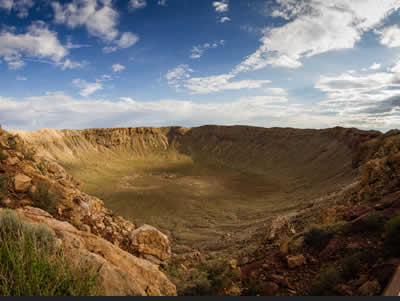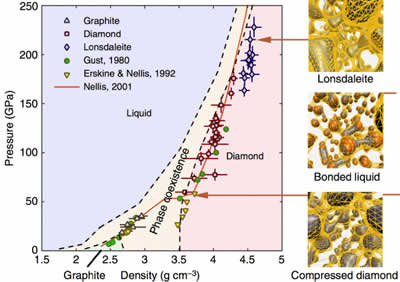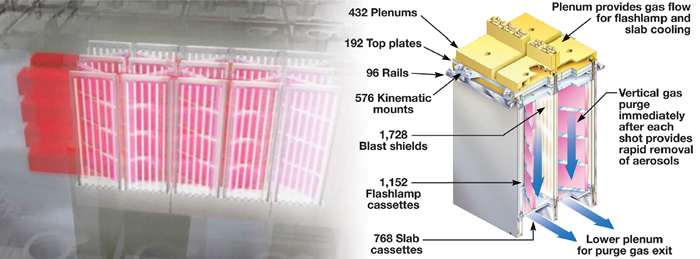Papers and Presentations - 2016
March
Got Questions About NIF? Here Are the Answers
When Meteorites Create Diamonds
In 1967 a hexagonal form of diamond, later named lonsdaleite, was identified for the first time inside fragments of the Canyon Diablo meteorite, the asteroid that created the Barringer Crater in Arizona. Since then occurrences of lonsdaleite and nanometer-sized diamonds have been speculated to serve as a marker for meteorite impacts, having also been connected to the Tunguska explosion in Russia, the Ries crater in Germany, the Younger Dryas event in sites  Arizona’s Barringer Crater. Credit: Rick Machacross Northern America, and more.
Arizona’s Barringer Crater. Credit: Rick Machacross Northern America, and more.
Scientists have hypothesized that lonsdaleite forms when graphite-bearing meteors strike the Earth. The violent impact generates incredible heat and pressure, transforming the graphite into diamond while retaining the graphite’s original hexagonal structure. Despite numerous theoretical and limited experimental studies, however, crucial questions have remained unresolved for short-time high-pressure environments relevant to meteor impacts—particularly the structural state immediately after the shock transit, the timescales involved, and the influence of crystalline orientation.
In a Nature Communications paper published on March 14, a team of researchers including scientists from NIF & Photon Science provide new insights into the process of the shock-induced transition from graphite to diamond and uniquely resolve the dynamics of the phase change.
The experiments show unprecedented in situ x-ray diffraction measurements of dynamic diamond formation on nanosecond timescales by shock compression of graphite starting at pressures above 0.5 Mbar (one Mbar = one million atmospheres). The team observed the direct formation of lonsdaleite above 1.7 Mbar, for the first time resolving the process that has been proposed to explain the main natural occurrence of this crystal structure being close to meteor impact sites.
“Due to difficulties in creating lonsdaleite under static conditions,” said lead author Dominik Kraus, “the overall existence of this crystal structure in nature has been questioned recently. However, static experiments cannot mimic fast dynamics such as those in violent meteor impact events. Here we show that we can indeed create a lonsdaleite structure during dynamic high-pressure events. This is interesting for modeling dynamic phase transitions in general, but also shows that the lonsdaleite found in nature could indeed serve as a marker for violent meteor impacts.”
Kraus conducted the research while working as a University of California, Berkeley, Physics Department postdoc sited within the NIF & Photon Science directorate. He now serves as a Helmholtz Young Investigator group leader at the Helmholtz-Zentrum Dresden-Rossendorf research laboratory in Germany.
 The experiments show dynamic diamond formation starting at pressures above 0.5 Mbar and the direct formation of lonsdaleite above 1.7 Mbar (170 GPa).
The experiments show dynamic diamond formation starting at pressures above 0.5 Mbar and the direct formation of lonsdaleite above 1.7 Mbar (170 GPa). The experiments were conducted at the Matter at Extreme Conditions (MEC) experimental area at the Linac Coherent Light Source (LCLS) at the SLAC National Accelerator Laboratory at Stanford. Graphite samples were shock-compressed to pressures of up to two Mbar to trigger the structural transitions from graphite to diamond and lonsdaleite. The phase changes in the high-pressure samples were probed with ultrafast (femtosecond) x-ray pulses created by LCLS.
“Such phase changes are very challenging for theory,” said Dirk Gericke, a physicist from the University of Warwick Centre for Fusion, Space and Astrophysics and one of the researchers on the paper. “ Thus, these interesting experimental data are very valuable for benchmarking future simulations. It is amazing that we can now follow the evolution of the phase transition with brilliant x-ray probes from the Linear Coherent Light Source; seeing the dynamics of the process gives much more insights than only having the initial and final state. This is a true new treasure for science.”
According to Kraus, this was the first in situ structure measurement of the shock-induced graphite-to-diamond transition. Before these experiments, all conclusions regarding this structural transition were based on the material that was recovered after applying the shock drive or dynamic measurements of macroscopic quantities, such as density and pressure.
“You won’t get rich from our experiments,” Kraus said, “but the shock-induced transition from graphite to diamond already has important industry applications. For example, nanometer-sized diamonds for fine polishing of materials are created by detonation of carbon-bearing explosives. These explosions typically generate pressures up to about 0.5 Mbar, just above the threshold of diamond formation. Here we show that above two Mbar, the lonsdaleite structure can be generated in a very pure form. Since pure lonsdaleite is supposedly even harder than diamond, this is highly interesting, and other groups now try to recover these samples after an experiment.”
Kraus was joined by LLNL co-authors Tilo Döppner and Benjamin Bachmann, and scientists from the University of California, Berkeley, SLAC, the University of Warwick, the Max Planck Institute, Technical University Darmstadt, Helmholtz-Zentrum Dresden-Rossendorf, the University of Oxford, and the GSI Helmholtz Centre for Heavy Ion Research.
The U.S. Department of Energy’s Office of Science and the German Federal Ministry for Education and Research funded the work.
Got Questions About NIF? Here Are the Answers
Almost everything you ever wanted to know about NIF—from how the laser works, to how targets are fabricated and optics are recycled, to how experiments are conducted and the results measured and analyzed—can be found in a just-published special issue of Fusion Science & Technology.
The January-February 2016 issue (Vol. 69, No. 1) of the American Nuclear Society publication is devoted to 12 technical papers tracing the historical development of NIF and its transition to a user facility to pursue fusion ignition and high energy density (HED) scientific research. The 470-page publication includes papers by dozens of LLNL researchers. Retired NIF&PS Chief Technologist Mary Spaeth was lead author on four of the papers and a co-author of two others.
 Images from the special issue of Fusion Science & Technology: (Left) An artist’s view of an approximately 15-nanosecond (about 15 feet long) NIF laser pulse moving through a large amplifier. (Right) Laser slab and flashlamp line replaceable units housed within their frame assembly unit support structures, showing the major components and the vertical-purge flow path.
Images from the special issue of Fusion Science & Technology: (Left) An artist’s view of an approximately 15-nanosecond (about 15 feet long) NIF laser pulse moving through a large amplifier. (Right) Laser slab and flashlamp line replaceable units housed within their frame assembly unit support structures, showing the major components and the vertical-purge flow path. NIF “is the culmination of 50 years of work directed toward providing a facility that can aggressively support HED science activities,” the authors said. “It provides important experimental capabilities to the (National Nuclear Security Administration) Stockpile Stewardship Program and supports both fundamental science experiments and research for the ignition of thermonuclear burn in the laboratory.
“This quest has involved several generations of scientists, engineers, and technologists at LLNL, the supporting institutions, and their industrial partners,” they said. “Credit for accomplishing the design, construction, and operation of NIF goes to the thousands of people who contributed the technical ideas and the follow-up effort…that can meet the (inertial confinement fusion)-specified needs for shot-by-shot performance and the routine operation that is planned for (NIF’s) 30-year lifetime.”
Topics covered in the special issue include:
- Development of NIF and results of the ignition campaign to date, by NIF&PS Chief Scientist John Lindl and colleagues
- A description of the NIF laser, by Spaeth and colleagues
- NIF operations, by Bruno Van Wonterghem and colleagues
- NIF diagnostics, by Joe Kilkenny and colleagues
- Damage mechanisms avoided or managed for NIF large optics, by Ken Manes and colleagues
- Target development, by Alex Hamza and colleagues
- The optics recycle loop strategy, by Spaeth and colleagues
- NIF control and information systems, by Gordon Brunton and colleagues
- The cryogenic target system, by Tom Parham and colleagues




